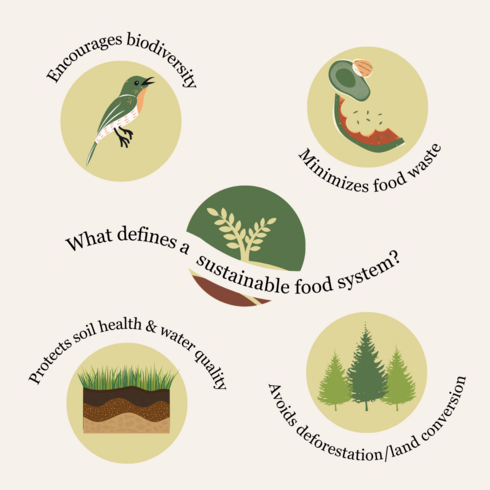
Food 101: Fixing a Broken System
- Date: 04 August 2022
- Author: Jesse Marcus, World Wildlife Fund
Global food production is a major driver of biodiversity loss around the world, primarily due to land conversion and degradation of critical ecosystems like tropical forests, grasslands, and wetlands.
Food production consumes over 70% of freshwater globally and is a major source of pollution. Global food systems are also impacting climate change, contributing over one-quarter of anthropogenic global greenhouse gas emissions annually—especially methane and nitrous oxide. Those food systems are in turn impacted by climate change, as they are vulnerable to the impacts of higher temperatures as well as more extreme and unpredictable weather events.
And that’s not all: dwindling natural resources, new infectious diseases, unstable markets, widening social and economic inequities—all these environmental and development challenges are at least in part a consequence of our broken food system.
I wanted to better understand how these challenges—and the solutions to them—all fit together, so I asked a diverse array of WWF experts to offer their unique perspectives on the food crisis.

Melissa D. Ho, Senior Vice President, Freshwater and Food, made the case for a conscious shift to “regenerative, resilient food systems,” which means that we must change how we produce and consume food to be more in line with planetary boundaries and in the face of climate change. According to Ho, regenerative food systems must deliver healthy, accessible food, thriving livelihoods and communities, while ensuring the sustainability of our natural resources and biodiversity. It is possible to feed the world without destroying its natural capital, but we need a paradigm shift from systems that are extractive and wasteful to those that are restorative and resilient.
“Humanity’s current production and consumption of food is one of our greatest conservation challenges,” said Ho, “but it also is one of our greatest opportunities to make a positive impact. We must act now, as we are hitting the limits of what the planet can bear. Food is such a basic part of human culture and well-being – the food we eat every day should not only nourish our bodies, it should also nourish our connections to family, to community, and to the environment.”
Throughout millennia, she explained, agriculture has been about the intersection of people and place. Regenerative food systems re-establish a critical connection between consumers, producers, and the environment, because they manage for and value healthy soil, clean water, thriving freshwater ecosystems, and vibrant biodiversity. Regenerative food systems integrate circularity of natural resources by design, eliminate unnecessary waste and loss, and don’t destroy natural habitat to expand production of crops and livestock.
“By re-centering our current food system around regenerative principles,” Ho asserted, “we can feed and nourish the world and still address the climate crisis, restore biodiversity, and protect nature now and for future generations.”
How we produce food is important to achieve this vision for a regenerative food system. For Martha Kauffman, Vice President, Northern Great Plains, our rampant destruction of natural habitat to plant crops and raise livestock is tantamount to cutting off our nose to spite our face. Converting millions of acres of natural grasslands each year to plant crops is deeply problematic, exacerbating climate change and biodiversity loss. “Ecosystems like grasslands and savannahs offer myriad benefits,” she told me. “They provide habitat for wildlife, mitigate flooding and ensure clean drinking water, store vast amounts of carbon, and support the nutritional health, livelihoods, and cultural values of millions of people.”
“They’re also vanishing at a faster rate than any other biome on Earth,” Kauffman added. “The main driver behind this loss is the conversion of land for agriculture...but it doesn't have to be. By shifting to more sustainable grazing and farming practices, we can improve soil health and water quality while also protecting and restoring critical habitats—a boon for both people and nature."
On the other hand, consumption patterns must also change to shift to a food system that restores the environment. Pete Pearson, Senior Director, Food Loss and Waste, made a strong case for food waste as an obvious low-hanging fruit. “Every year, as much as 40% of the food produced around the world ends up lost or wasted,” Pearson told me. “Producing food that no one eats requires a great deal of land, water, energy, and human labor. It also contributes to climate change by generating significant amounts of greenhouse gas emissions—not just from the agricultural processes used to grow, refrigerate and distribute food, but also from landfills where wasted food is buried and releases methane emissions. Preventing food waste and creating a circular food economy is a global imperative.”
Governments can help establish the enabling conditions for this kind of transformational change, but only the private sector has the ingenuity, resources, and reach to make it happen. “That’s why we need a new business plan for feeding humanity’s growing population,” asserted Jason Clay, Senior Vice President, Markets. “Food companies, with help from the financial institutions that undergird their business, need to remove habitat loss and degradation from their supply chains, and persuade their suppliers to prioritize conservation and restoration.”
The good news: now more than ever, industry leaders are acknowledging the risks associated with climate change and biodiversity loss. “Rising seas, extreme weather events and other climate impacts are already disrupting supply chains and destabilizing markets,” Clay told me, adding that “a combination of land degradation and rising temperatures will increasingly hurt productivity and exacerbate resource scarcity in the coming years.”

In summation, we know what to do; we just need to the marshal the resources and the will to affect the change we seek. You can learn about and take action in important issues like preserving grasslands and ending food loss and waste. For any nation or community concerned about the health and prosperity of its citizens, for any business concerned about its bottom line, for any person concerned about the world their children and grandchildren will inherit, the time to act is now.